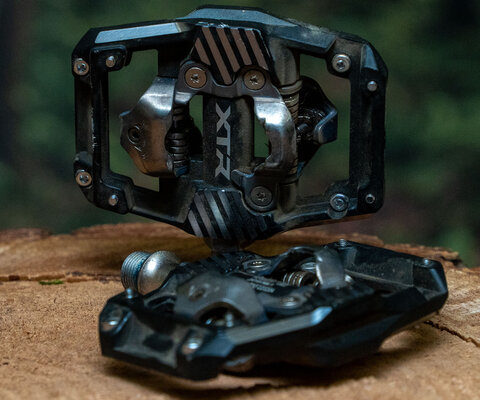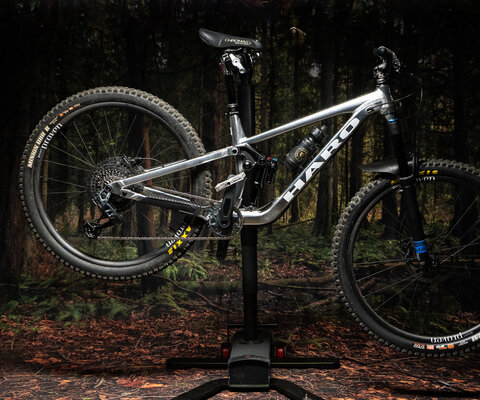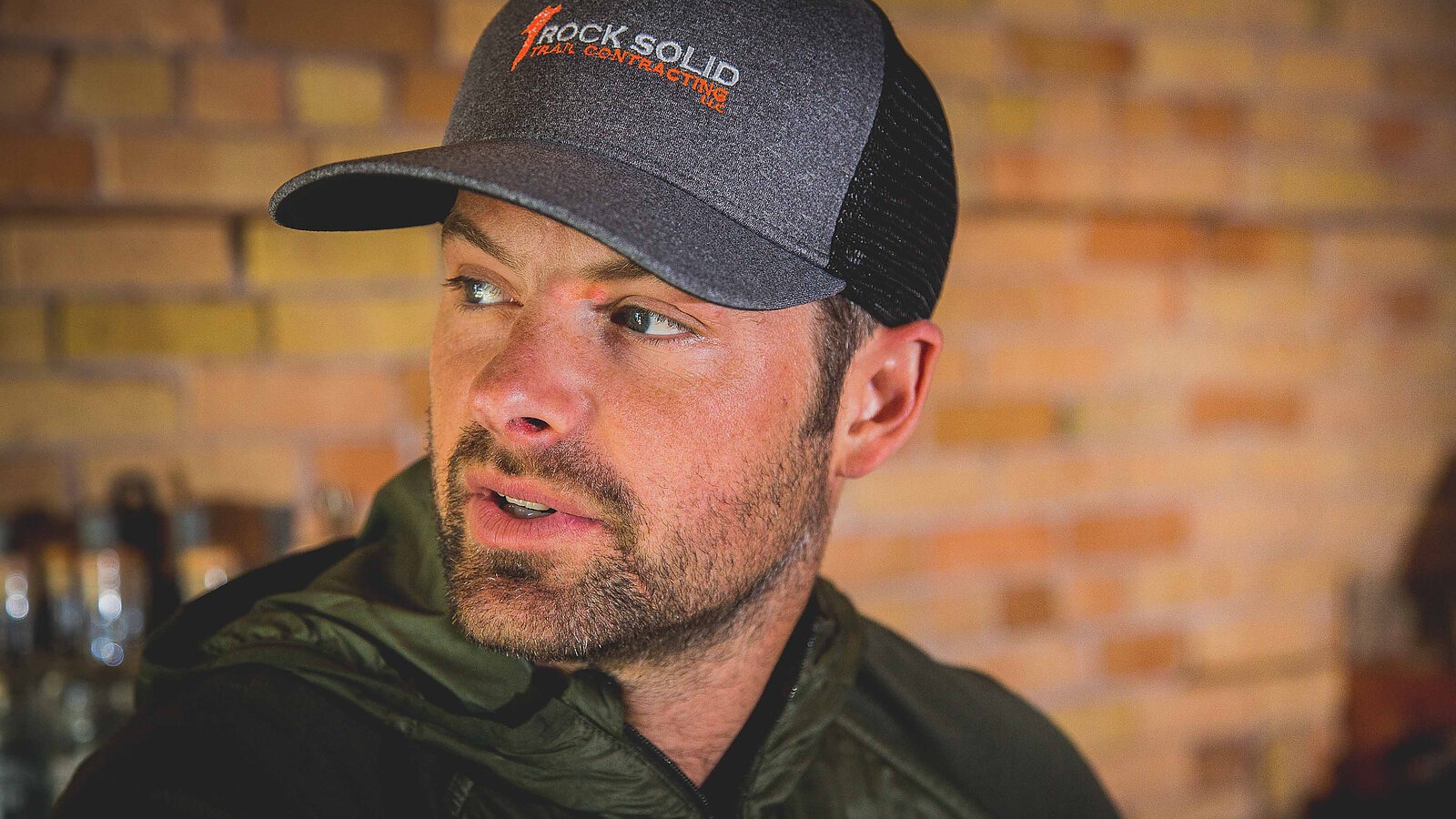
Defining Grade A Beyond the Best with Aaron Rogers
Words and Photos by Hansi Johnson
In the far reaches of the Upper Midwest trail-building scene, one name is repeated over and over.
That name is Aaron Rogers, and you’ll find him at the end of the road.
More specifically, the end of Michigan’s State Highway 41. Driving north through the Keweenaw Peninsula, on the south shore of Lake Superior, you’ll reach the highway’s first stop sign about an hour past Calumet, in the small town of Copper Harbor. You’ll reach the end a few hundred yards past that.
A decade ago, “the Harbor” (population 88) was mainly a stop for tourists on driving tours of Lake Superior or loading canoes onto the ferry for Isle Royal National Park, but by the early 2000s that flow had become a trickle. The community needed to find a new way to survive, a difficult task for a place essentially located at the edge of nowhere.
Aaron, however, had an idea—or, more accurately, a vision. Aaron moved to the area in 2005, and while working as a bike mechanic he realized Copper Harbor had the potential to be a world-class mountain biking hotspot that would attract riders from around the country to this little corner of the Upper Midwest. There was just one problem. Those world-class trails didn’t exist, at least not in the necessary quality or quantity.
A decade later, Copper Harbor hasn’t just become a model of world-class trails, but it’s also become an example of what such trails can provide, culturally and economically, for similar communities across the country. Aaron and his incredible trail-building skills were—and still are—integral to that remarkable Midwest transformation, pushing the craft from a tiny town at the end of the road.
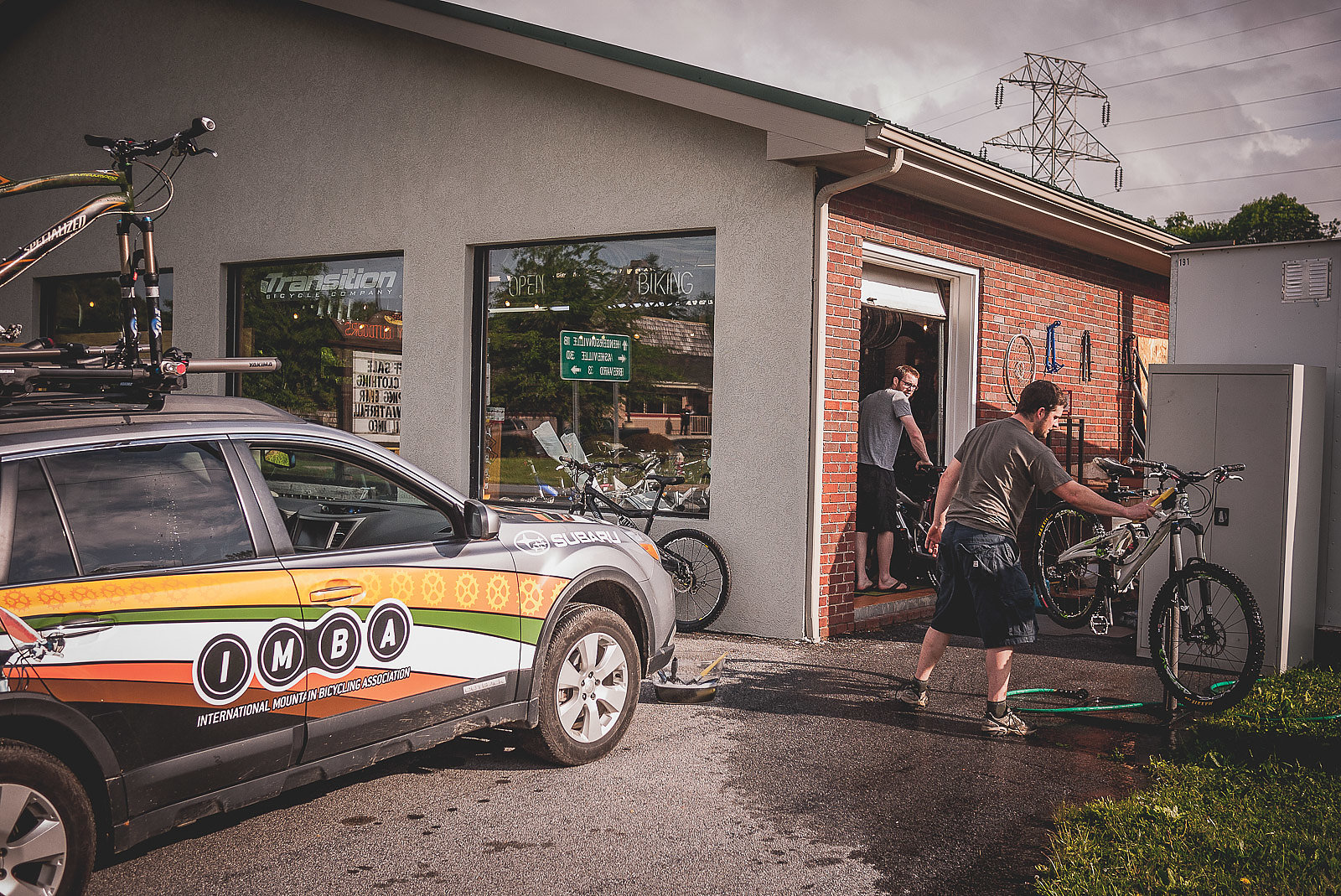
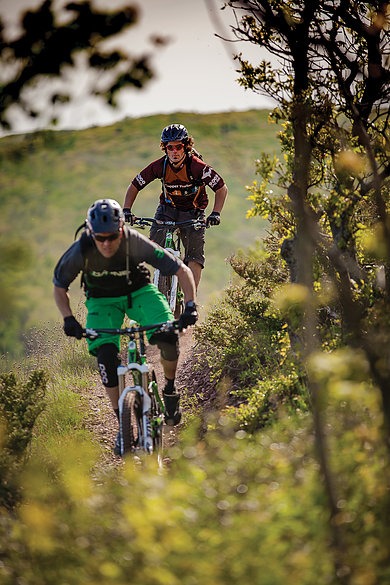
To understand Aaron and his importance to Midwest mountain biking, I have to layer in some history, both my own, and that of the area’s riding scene in general.
In 2008, I was hired as one of the International Mountain Bike Association’s (IMBA) regional directors. The positionwas new, and after some encouraging words I was essentially shoved into an IMBA-branded Subaru and told to grow membership and create positive change in my region.
That region was the Upper Midwest, and at that time off-road bicycling in the area was a shadow of what it is today. There were bright spots, certainly, but the modern quality of riding simply didn’t exist. As I figured it, all good mountain bike destinations start with grade A trails, so the best way to grow the sport in the area was to figure out what “grade A” meant. Simple, right?
My inaugural year, I drove almost 70,000 miles in that damn Subaru, visiting nearly every trail system, trail builder and club in Minnesota, Wisconsin, Iowa, Illinois, northern Missouri, and upper Michigan. “Grade A,” I soon learned, had to do with stupefying difficulty—uphill difficulty. Fun was ass-busting, ultra-long cross-country epics, with ridiculously steep climbs and trails so narrow they were barely rideable. The notion of “flow” was always mentioned, as in “our trails are flowy,” but in reality they tended to be tight, muddy, slow-speed slogs, with a little bit of magic peppered in.
Along the way, I also kept hearing about a crazy trail builder in the northern reaches of Michigan’s Upper Peninsula. With wild eyes and bushy hair, the man would carry a gas-powered jackhammer into the hills above Lake Superior, bench-cutting trails into the solid rock. I knew the area’s residents tended to be a special breed, some batshit crazy, some slightly crazy, and a few free thinkers of some backwoods Renaissance.
Whichever this man was, he sounded like my kind of guy, so I pointed the IMBA Subaru north on Highway 41 toward Copper Harbor. And that’s how I met Aaron Rogers.
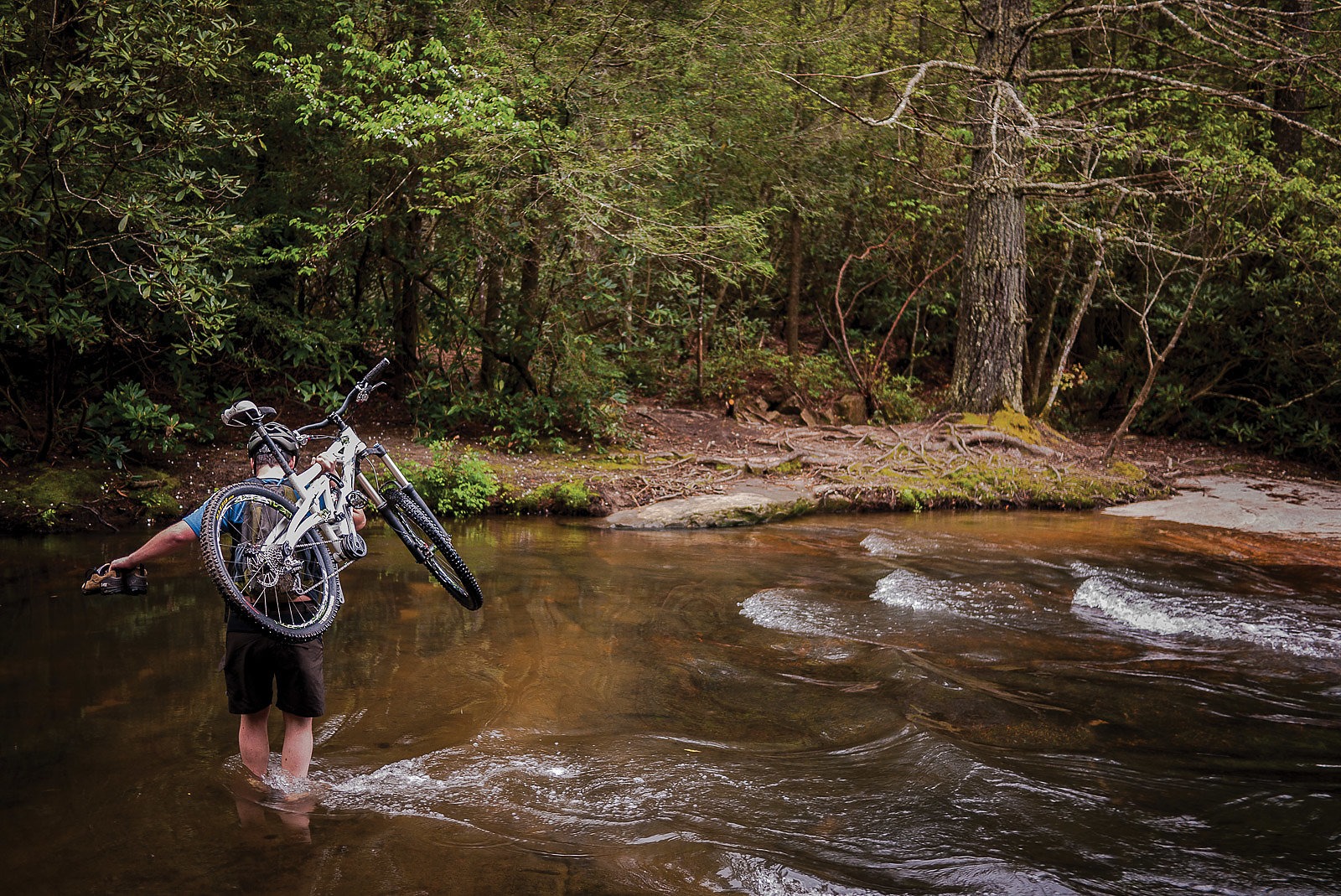
The Harbor would be beautiful anywhere in the world. Located on the southern coast of Lake Superior, it’s an embarrassment of rugged, rocky shoreline and pristine beaches, ringed with stunning bluffs (the locals call them “mountains”) perfect for mountain biking. Hardwoods mix with massive white pines and ancient cedar stands, a green contrast to the inland sea’s curving blue horizon.
Rogers and I hit it off immediately on that first trip to the Harbor. For one, we loved similar things outside of mountain biking, such ashunting, fishing and generally just hanging out in remote places. As we walked Aaron’s trails, it was easy to see how he was intentionally capitalizing on speed and weightlessness, foreshadowing the modern definition of “flow.”
As our discussions deepened, we also realized we had a similar vision for off-road cycling’s potential role in the Upper Midwest, especially the Lake Superior region. I wanted to grow mountain biking in the Midwest; Aaron wanted to build trails that did the same for his community. If we learned more about the riding destinations where this was already happening, we decided, we could use Copper Harbor as our test model.
Fun fact: In the United States, the concept of professionally designed, professionally built trails didn’t come from the classic hotspots. It came from the Southeast, where trailbuilding was already a decade-plus ahead of the rest of the country. When we heard some of these modern and “destination” trail systems were to be showcased at the 2010 IMBA World Summit in Augusta, GA, Aaron and I hatched a plan. We’d drive the IMBA Subaru from Copper Harbor to Georgia and ride every major trail system along the way.
The stories from that pilgrimage could fill a book. Sleep was optional and chamois cream mandatory. We rode our legs off, met tons of people, saw countless miles of trail, and arrived at the summit with prolific notes. But after leaving Augusta, we knew such keynote-quality trails could be reproduced in our region—and, for Aaron, improved upon. Having seen the best of the era, he realized he could challenge and change that standard, and he could do it in Copper Harbor.
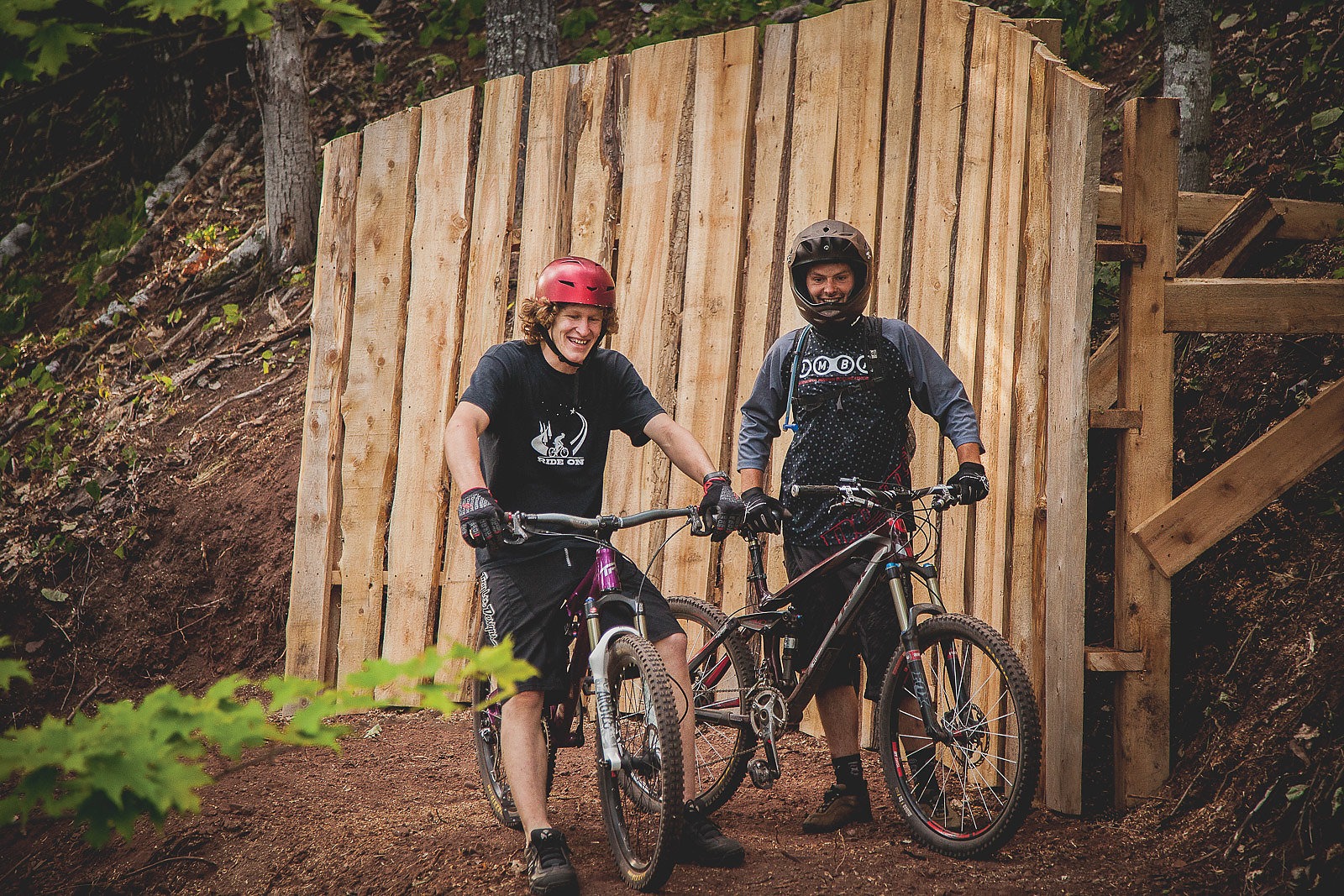
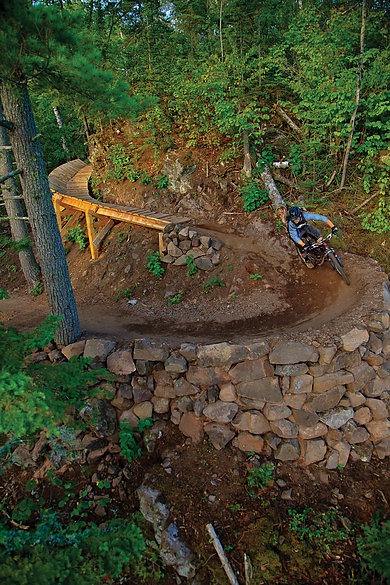
A few weeks after the summit, Aaron was back in Copper Harbor, armed with a wealth of new knowledge and a mini excavator. He began renovating and redesigning his home trail system, carefully learning the “rules” of building trails with flow in mind and using every inch of the area’s vertical. He cranked out new trails like Over the Edge and the aptly named the Flow, while also revamping the iconic Garden Brook Trail. Aaron’s skills increased with every new mile, as did the ensuing riders’ sense of enjoyment. Regardless of technicality or skill level, even in those early years I’d say Aaron’s trails had a high “Wee factor,” as in, “WEEEEE!!!!”
What began as solid, cross-country-style singletrack progressed to more creative and imaginative gravity trails, and then into innovative combinations of the two. Copper Harbor has no shortage of rock, and Aaron became adept at intricate stonework at a near-landscape-architecture level, creating trails that were both fun to ride and visually unique. By 2009, Copper Harbor’s trails had an “Epic Ride” designation from IMBA; by 2011, that had been upped to a Bronze Level Ride Center. In 2012, the Harbor was designated an IMBA Silver Ride Center, becoming one of only 15 in the world.
Soon, influential trail builders and mountain bikers were showing up, eager to see what was generating all this fuss in the Michigan backwoods. It even drew the likes of Aaron Laroque and Andrew Shandro, who chose the area to shoot the release video for Trek Bikes’ Slash. Builder, professional athlete or amateur, the feedback was universal: Aaron’s trails were world class. Copper Harbor had become a destination- worthy mountain bike town.
For me, it was a window into the future, and I spent as much time as my family and job would allow in Copper Harbor—not only to see Aaron’s newest creation, but also to continue scheming and dreaming. Like all true artists, as Aaron learned the rules of trailbuilding he also learned to bend them and, in some cases, break them entirely. He devised trails that not only rode amazingly well, but could also be easily maintained by local clubs while remaining environmentally friendly. By building in memorable, photogenic features, he left riders with a lasting impression of what a trail could be.
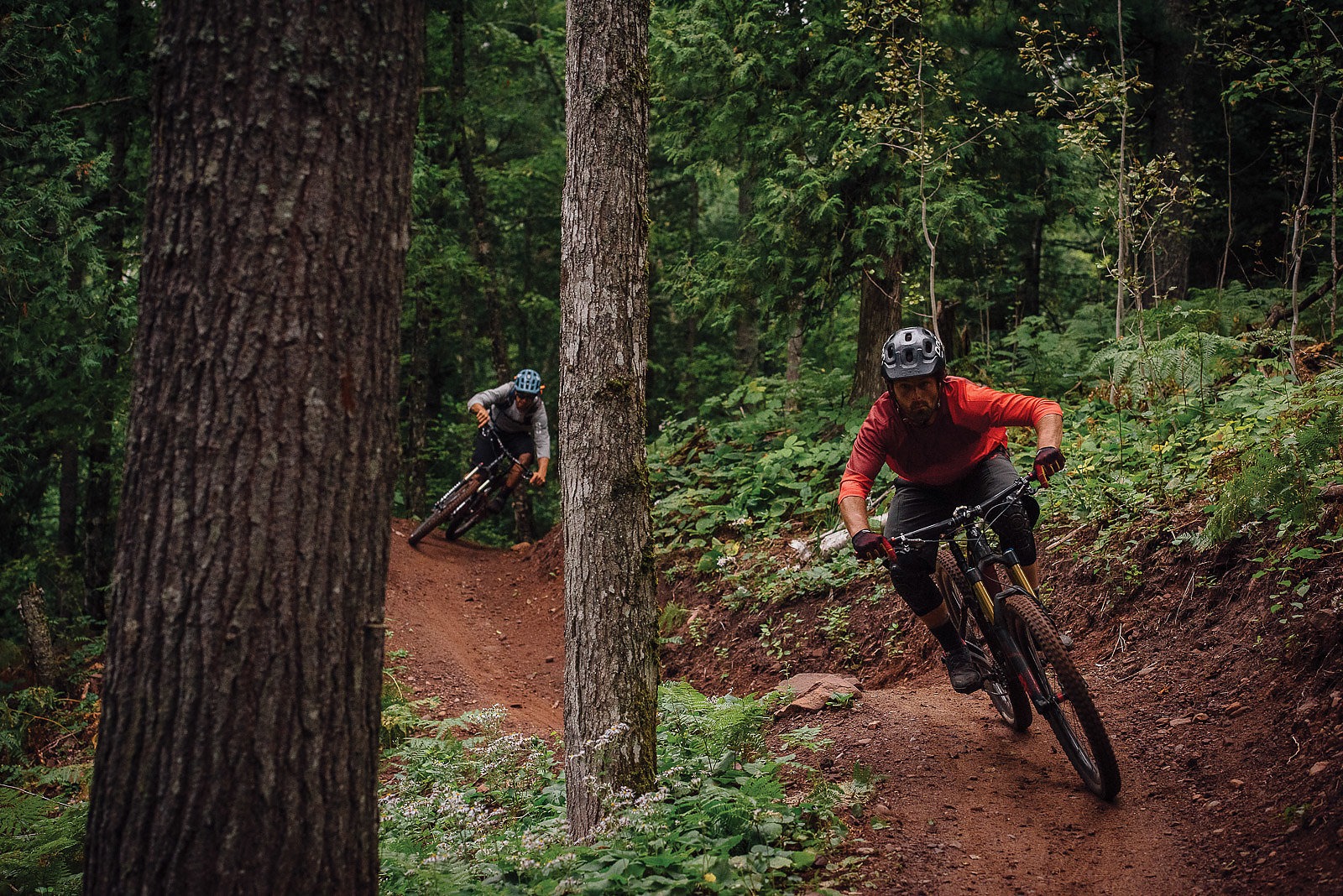
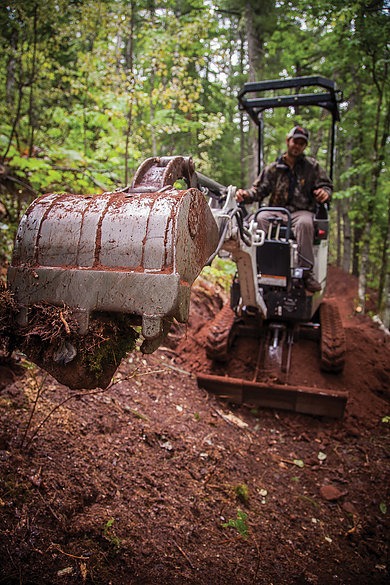
“In my opinion, I would rather ride one wellbuilt, action-packed trail over and over than just go out and cover miles,” Aaron says. “As an artist who works with natural materials, I think you have a responsibility to create unique experiences that mesh into each individual landscape. The best part is we get to define what that means, to us and the greater trail community, and I’ve always been up for that task.”
As Copper Harbor became a role model for what modern, pro-built trails could provide, other communities in the Upper Midwest became thirsty to create something similar in their towns and Aaron found himself in huge demand across the region as a hired gun of the highest order.
As a contract builder, however, he had plenty to learn on the business side of the process. As a regional advocate, I saw the value of getting Aaron and his amazing work wider exposure; to Though thedo so, he’d need a better understanding of the trail-building industry. IMBA could provide that education, and eventually Aaron was offered a job with IMBA Trail Solutions, with a focus on supporting the Midwest region.
In trail building, the mark of a true professional doesn’t show in epically difficult pieces of double-black singletrack; it shows in their ability to create the perfect green ones. Along with expanding his building knowledge, the IMBA position taught Aaron how to work with clients to deliver specific types of trail product and manage contract gigs within a fixed budget. His resume grew to include projects across the country, with a variety of machines and crews. Soon he had the skill and drive to strike out on his own, and in 2014 Aaron parted ways with IMBA and started Rock Solid Trail Contracting.

Rock Solid was immediately overbooked, and Aaron went from a one-man show to managing a crew of seven nearly overnight. From Duluth and Cuyuna Lakes, MN, to Lacrosse, WI, communities across the Upper Midwest wanted the company to build their dream trails, knowing they’d get grade A quality within a budget they could handle.
Aaron’s stout work ethic is one of the reasons Rock Solid makes such damn good trail, but it also meant the company cycled through workers like a revolving door. Eventually, Aaron assembled a team he could trust, and as his early partner in crime, one-time coworker and longtime friend, I watched the Rock Solid crew evolve into a tight, hardworking and successful trail building organization.
On that initial fateful road trip to Augusta in 2010, Aaron and I had been lucky enough to meet Nathan “Woody” Woodruff, owner of the Bentonville, AR-based company Progressive Trail Design. Aaron and Nathan had kept in touch over the years, and when Nathan needed help on some of Progressive’s larger projects he reached out to Rock Solid. Aaron and his crew began regularly assisting on huge, high-mileage jobs across North America, and doing so much work in northwest Arkansas that Aaron began to migrate between Copper Harbor in the summer and Bentonville in the winter.
There is a rare situation in the art world in which a benefactor not only sees an artist’s vision but also understands and values their work. Though he didn’t know it at the time, Aaron would be presented with such an opportunity when he met Tom Walton during a group ride at the Augusta summit. Tom is the grandson of Helen and Sam Walton, the founders of Walmart; he is also an avid mountain biker who lives in Bentonville, so when Tom and his brother Steuart wanted to upgrade the private trail system on the Walton Family Farm they brought in Aaron and Rock Solid.
It was not only a build to push their skills, but also one to savor, as the terrain on the farm was a perfect fit for the crew—lots of vertical relief and lots of stone to work with, combined with enough financial freedom to flex their imagination. The results were stunning, both visually and physically, with high-speed descents, hefty hits and drops, and a climbing trail that flowed like water, only uphill. I asked Aaron how it compares to other projects over the years while visiting him in Arkansas last spring.
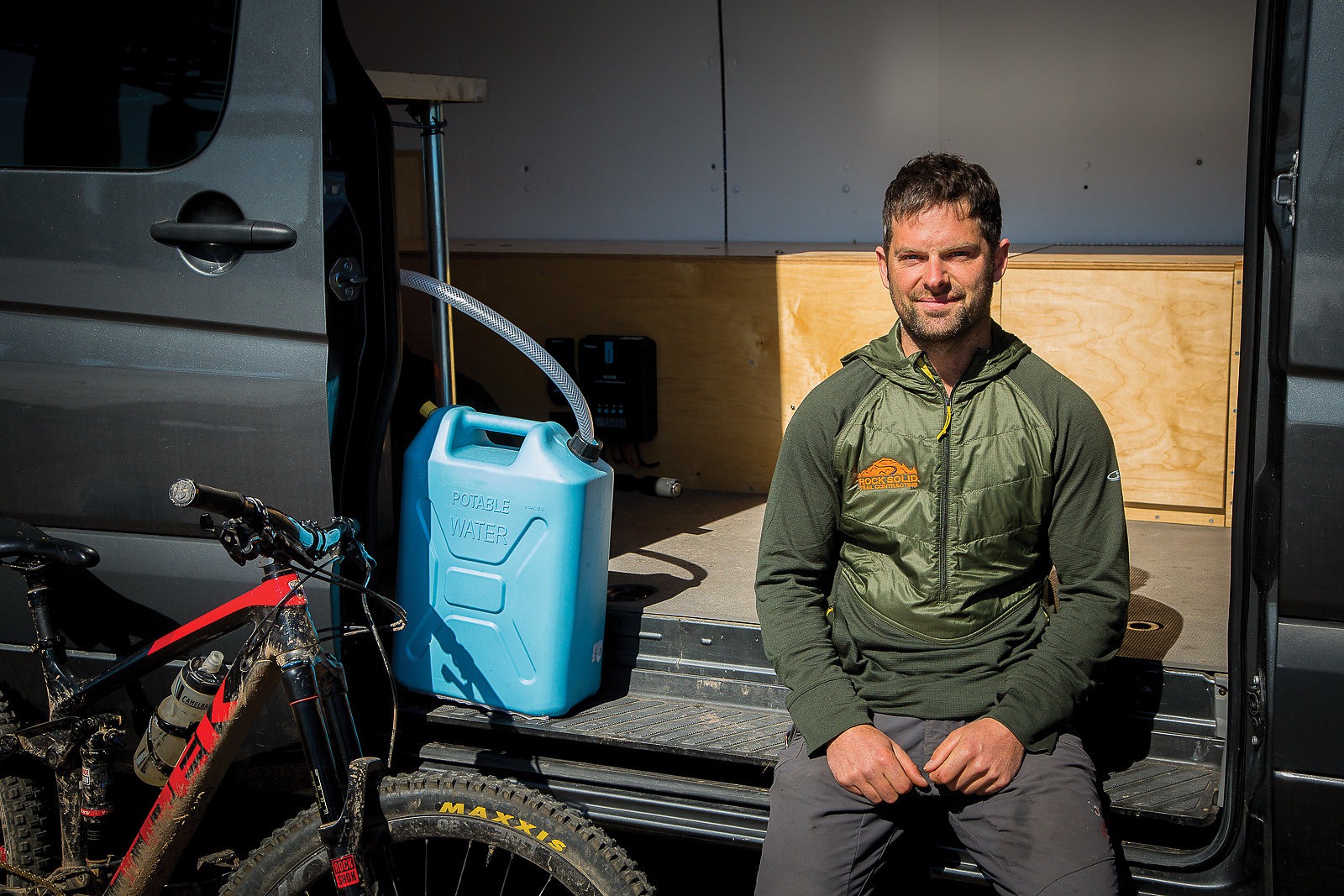
“My favorite builds have always been at Copper Harbor, and now in Bentonville as well,” he says. “In the Harbor, that’s primarily because of the lack of restrictions on creative ability; in the case of Bentonville, they’re also willing to provide the proper budget as not to restrict that creativity.”
To date, Rock Solid has built more than 200 miles of trail in 25 different communities, including the Duluth Traverse and Trek Bikes’ personal network in Waterloo, WI, as well as projects in California, New Mexico, Hawaii, Arkansas and Canada. But while the crew continues to have a steady diet of Arkansas dirt, Aaron hasn’t neglected his hometown. On a local level, his main push is continued construction on the Keweenaw Point Trail, or KPT.
Once finished, the KPT will sit high on every mountain biker’s bucket list: a mix of hand- and machine-built singletrack linking numerous stunning Lake Superior vistas, winding from sandy and loamy berms to gnarly conglomerate rock, studded with round gravel from the ancient Lake Superior shorelines. Depending on the wind, on some sections riders might have to literally dodge incoming waves.
Aaron has a few signature projects of his own in the works as well, including a new campground he and a friend recently opened along the Copper Harbor trail system, complete with a little bike park. His most ambitious is what he’s calling the “East Bluff Project.” This ride-in, ride-out community would include its own trail network that would integrate into the town’s existing system and be open to the public, as well as having space for light, place-specific development.
With pristine views of Lake Superior, untouched white sand beaches and uninterrupted forest for miles, there are few better places to make it happen than the end of State Highway 41. It’s a big vision, but that’s fine. Aaron is up to the task.

